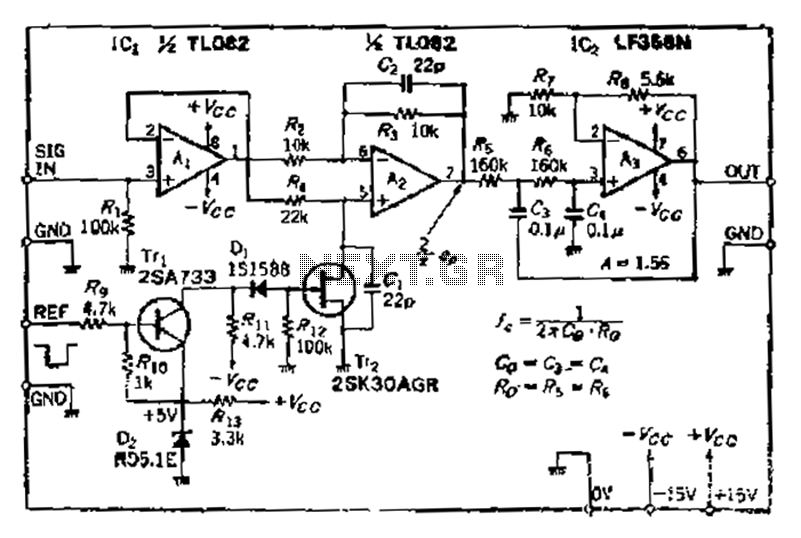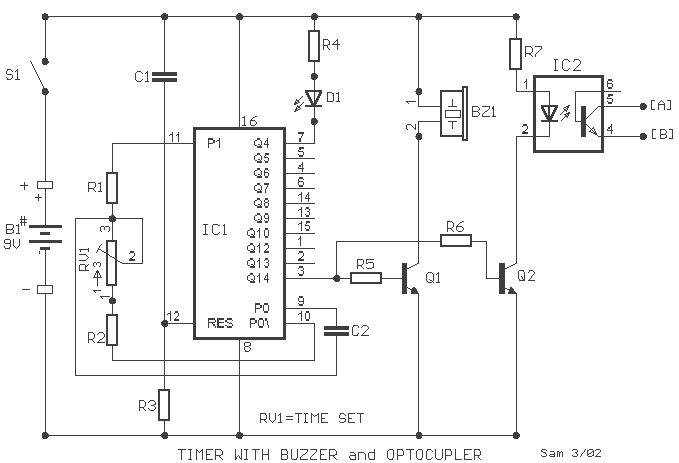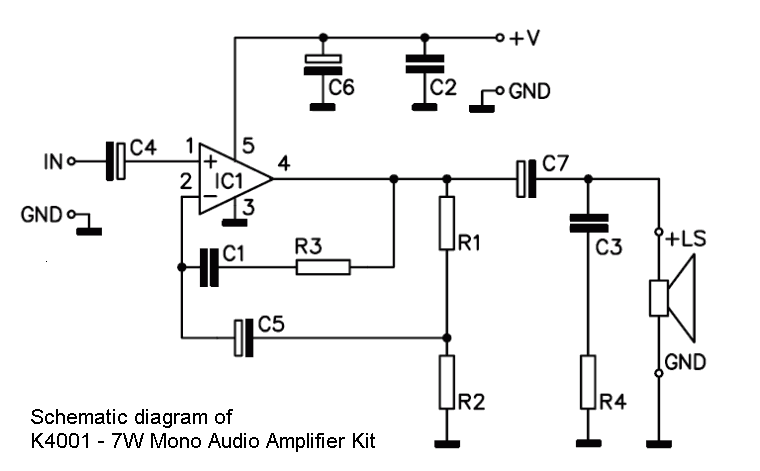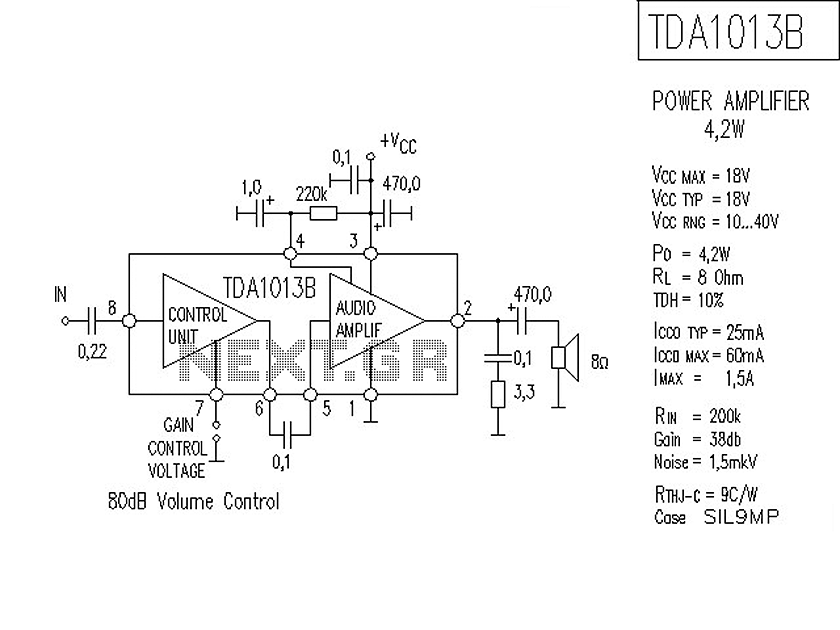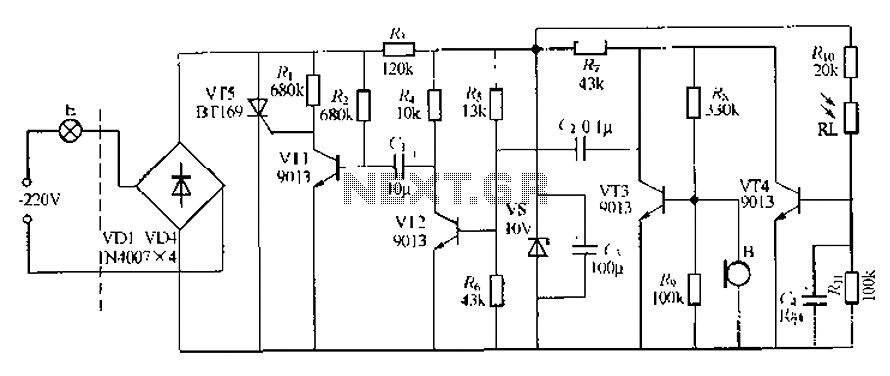
FM IF amplifier circuit composed of ceramic filters
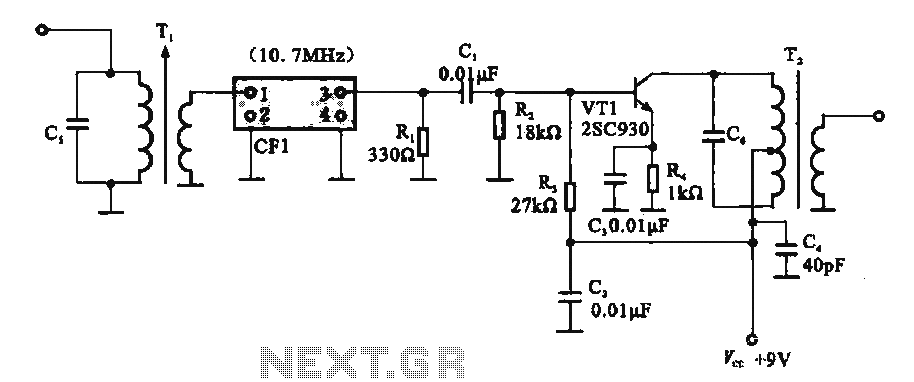
This circuit features a ceramic filter integrated with an FM intermediate frequency (IF) amplifier. The FM IF amplifier circuit primarily consists of an input variable voltage regulator (T), ceramic filters (CF1), and additional components such as the IF amplifier and IF transformer (T2, VT1). These components are utilized to amplify the FM IF signal. The IF signal, originating from the FM front-end circuitry at 10.7 MHz, is directed into the primary winding of the first transformer (T1), which forms a resonant circuit that provides frequency selection. The secondary winding of transformer T1 is connected to a 10.7 MHz ceramic filter, which transmits the selected intermediate frequency signal to the base of transistor VT1 for amplification. The amplified signal from VT1 is then outputted through the second intermediate frequency transformer (T2) to the next stage of the circuit. The overall design is characterized by a simple structure and effective performance.
The FM IF amplifier circuit operates by receiving an intermediate frequency signal at 10.7 MHz, which is a standard frequency for FM radio systems. The circuit begins with the input signal being fed into the primary winding of transformer T1, which is configured as part of a resonant circuit. This configuration allows for selective amplification of the desired frequency while attenuating others, ensuring that only the relevant signal is processed.
The ceramic filter CF1 plays a crucial role in this setup by providing a narrow bandwidth around the 10.7 MHz frequency. This filter is essential for maintaining signal integrity, as it reduces interference from adjacent channels and enhances the overall quality of the received signal. The output of the ceramic filter is then connected to the base of transistor VT1, which serves as the main amplification stage of the circuit. Transistor VT1 amplifies the selected intermediate frequency signal, increasing its amplitude for further processing.
Following amplification, the signal is passed to the secondary transformer T2, which further conditions the signal before it is sent to the next stage of the FM receiver. The use of transformers in this circuit helps in impedance matching and allows for efficient signal transfer between stages.
Overall, this circuit exemplifies a straightforward yet effective approach to FM signal amplification, leveraging ceramic filters and transformers to achieve high performance in radio frequency applications. The design considerations prioritize simplicity and reliability, making it suitable for various FM receiver implementations.It shows a ceramic filter composed of FM IF amplifier circuit, the FM intermediate frequency amplifier circuit mainly by the IF input variable voltage regulator T}, ceramic filters CF1, IF amplifier and IF transformer T2 VT1 other parts can normally be used amplifying FM IF signal. IF from the FM front-end circuitry (10.7 MHz) into the first intermediate frequency signal TJ transformer primary winding which cs composition and frequency of the resonant circuit, having a frequency selection function, Tl transformer secondary connected with a 10.7 MHz ceramic filters it will send the selected intermediate frequency signal to an intermediate frequency amplifier at the base of the transistor VT1, amplified. VT1 amplified signal and then by the second intermediate frequency transformer Tz output to the next level.
The circuit has a simple structure, good performance characteristics.
The FM IF amplifier circuit operates by receiving an intermediate frequency signal at 10.7 MHz, which is a standard frequency for FM radio systems. The circuit begins with the input signal being fed into the primary winding of transformer T1, which is configured as part of a resonant circuit. This configuration allows for selective amplification of the desired frequency while attenuating others, ensuring that only the relevant signal is processed.
The ceramic filter CF1 plays a crucial role in this setup by providing a narrow bandwidth around the 10.7 MHz frequency. This filter is essential for maintaining signal integrity, as it reduces interference from adjacent channels and enhances the overall quality of the received signal. The output of the ceramic filter is then connected to the base of transistor VT1, which serves as the main amplification stage of the circuit. Transistor VT1 amplifies the selected intermediate frequency signal, increasing its amplitude for further processing.
Following amplification, the signal is passed to the secondary transformer T2, which further conditions the signal before it is sent to the next stage of the FM receiver. The use of transformers in this circuit helps in impedance matching and allows for efficient signal transfer between stages.
Overall, this circuit exemplifies a straightforward yet effective approach to FM signal amplification, leveraging ceramic filters and transformers to achieve high performance in radio frequency applications. The design considerations prioritize simplicity and reliability, making it suitable for various FM receiver implementations.It shows a ceramic filter composed of FM IF amplifier circuit, the FM intermediate frequency amplifier circuit mainly by the IF input variable voltage regulator T}, ceramic filters CF1, IF amplifier and IF transformer T2 VT1 other parts can normally be used amplifying FM IF signal. IF from the FM front-end circuitry (10.7 MHz) into the first intermediate frequency signal TJ transformer primary winding which cs composition and frequency of the resonant circuit, having a frequency selection function, Tl transformer secondary connected with a 10.7 MHz ceramic filters it will send the selected intermediate frequency signal to an intermediate frequency amplifier at the base of the transistor VT1, amplified. VT1 amplified signal and then by the second intermediate frequency transformer Tz output to the next level.
The circuit has a simple structure, good performance characteristics.

